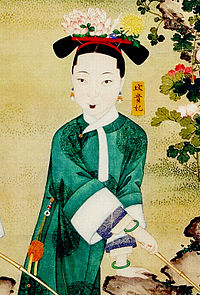Noble Consort Wen
| Noble Consort Wen | |
|---|---|
 Noble Consort Wen | |
| Born | 1835 |
| Died | 20 December 1890 (aged 54–55) Forbidden City |
| Burial | Ding Mausoleum, Western Qing tombs |
| Spouse | |
| House | Xu (徐; by birth) Aisin Gioro (by marriage) |
| Father | Chengyi (诚意) |
| Noble Consort Wen | |||||||
|---|---|---|---|---|---|---|---|
| Chinese name | |||||||
| Traditional Chinese | 玟貴妃 | ||||||
| Simplified Chinese | 玟贵妃 | ||||||
| |||||||
| Manchu name | |||||||
| Manchu script | ᡤᡝᡥᡠᠩᡤᡝ ᡤᡠᠢᠢᡫᡝᡞ | ||||||
| Romanization | gehungge guifei | ||||||
Noble Consort Wen (simplified Chinese: 玟贵妃; traditional Chinese: 玟貴妃; pinyin: Wén Guìfēi; 1835 – 20 December 1890), of the Manchu Plain Yellow Banner Xu clan, was a consort of Xianfeng Emperor.
Life
Family background
Noble Consort Wen was a Manchurian Booi Aha of the Plain Yellow Banner Xu clan, a branch of a prominent Šumuru clan.
Father: Chengyi (诚意), served as an official (Chinese: 领催; pinyin: Lǐng cuī).[1]
Daoguang era
Noble Consort Wen was born in 1835.
Xianfeng era
Lady Xu entered the Forbidden city in 1853 and was granted a title "First Class Female Attendant Wen" (玟常在). Lady Xu was described as a beautiful and elegant woman. Thus, she was favoured by Xianfeng Emperor. In May 1854, she was promoted to "Noble Lady Wen" (玟贵人).[2] Her residence in Forbidden City was Palace of Eternal Harmony.
In 1855, Noble Lady Wen was demoted for the first time to a "First Class Female Attendant Wen" (玟常在) from reasons unknown.[3] In July 1855, she vented her anger on the palace maid. While the severe punishment was being performed, Lady Xu was joking with an eunuch. That incident infuriated Xianfeng Emperor so much that she was demoted to a chosen maid (官女子).[4] The head eunuch of her residence, Sun Laifu (孙来福), was sent into slavery.[5]
The demotion meant exclusion from the imperial harem because rank "chosen maid" was not included in the official list. Her clan was downgraded to Booi Aha (bondservants) in one month. Xianfeng Emperor restored lady Xu as "First Class Female Attendant Wen" (玟常在) on 25 July 1856, and to "Noble Lady Wen" (玟贵人) shortly after the previous promotion.[6] Noble Lady Wen was promoted to "Concubine Wen" (玟嫔) in April 1858. On 8 January 1859, she gave birth to the second imperial prince.
Tongzhi era
In 1861, after the ascension to the throne of Tongzhi Emperor, Concubine Wen was promoted to "Consort Wen" (玟妃). In 1873, her son was posthumously honored as "Prince Min of the Second Rank" (悯郡王, "min" meaning "sympathy"). On 8 December 1874, Consort Wen was elevated to "Noble Consort Wen" (玟贵妃).
Guangxu era
Noble Consort Wen died on 20 December 1890. Her coffin was temporarily placed at Tiancun Immortal Palace and later interred in the Ding Mausoleum in the Eastern Qing tombs alongside Imperial Noble Consort Zhuangjing.[7]
Titles
- During the reign of the Daoguang Emperor (r. 1820–1850):
- Lady Xu (from 1835)
- During the reign of the Xianfeng Emperor (r. 1850–1861):
- First Class Female Attendant Wen (玟常在; from 1853), seventh rank consort
- Noble Lady Wen (玟贵人; from May 1854), sixth rank consort
- First Class Female Attendant Wen (玟常在; from 1855), seventh rank consort
- Chosen Maid (官女子; from unknown date)
- First Class Female Attendant Wen (玟常在; from 25 July 1856), seventh rank consort
- Noble Lady Wen (玟贵人; from unknown date), sixth rank consort
- Concubine Wen (玟嫔; from April 1858), fifth rank consort
- During the reign of the Tongzhi Emperor (r. 1861–1875):
- Consort Wen (玟妃; from 1861), fourth rank consort
- Noble Consort Wen (玟贵妃; from 8 December 1874), third rank consort
Issue
- As Concubine Wen:
- Prince Min of the Second Rank (憫郡王; 8 January 1859), second son
See also
References
- ^ 爱新觉罗家族全书: 世系源流 [A holistic genealogy of Aisin-Gioro clan] (in Chinese). 吉林人民出版社/Jilin State publisher. 1997. p. 419.
- ^ 《宮中雜件》 [Inner palace archives] (in Chinese).
- ^ 王/ Wang, 德恒/ Deheng (1997). 北京的皇陵与王坟 [Imperial tombs in Beijing] (in Chinese). 中国城市出版社. p. 197. ISBN 9787507408379.
- ^ 《欽定宮中現行則例》 [The rules of imperial harem, book 2] (in Chinese). 文海出版社. 1979.
- ^ 为景仁宮太監孫來福發往黑龍江給兵丁為奴事 (in Chinese).
- ^ 《清實錄‧穆宗毅皇帝實錄》 [The Record of Qing Dynasty·The Record of Emperor Mu Zongyi, book 6] (in Chinese).
- ^ 《清實錄‧穆宗毅皇帝實錄》 [The Record of Qing Dynasty·The Record of Emperor Mu Zongyi, book 373] (in Chinese).
